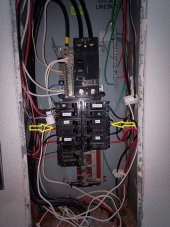Zwy
Solar Wizard
Note red arrow, you have a N-G from neutral busbar from EGC busbar with the green jumper located at the red arrow. This creates a parallel path.Well......wiring diagrams are nice pretty things. I can't say I have the patience to make a nice pretty thing but I put this together... I am including a couple of photos to spare myself from drawing out the details. The distribution panel is backfed through a couple of phase-aligned 40A breakers from the inverters. The utility panel feeds the inverters through a couple of phase-aligned 40 amp breakers. I built my combiner myself from a DIN project box. Each string feeds a 10A double pole DC breaker and I combine them in terminal blocks. Then I tap those split blocks 2x2 with a pair of 20A dual pole DC breakers for the inverter PV feeds.
As for the neutral, I'm assuming that is the larger (possibly #6 wire) white wire where the yellow arrows are located?

As you have a bond in the service panel shown below, the green jumper wire should not be present in the distribution panel.



